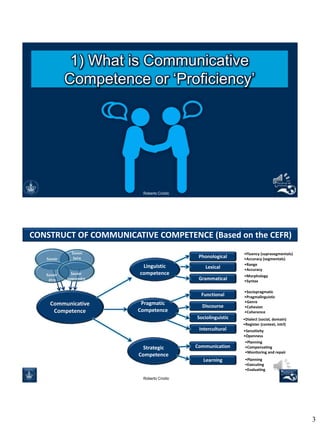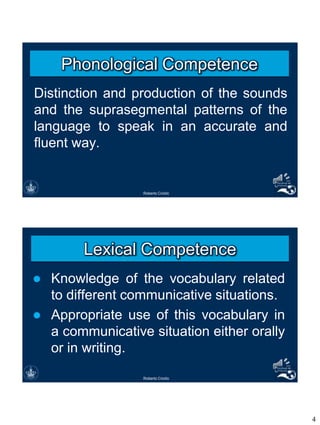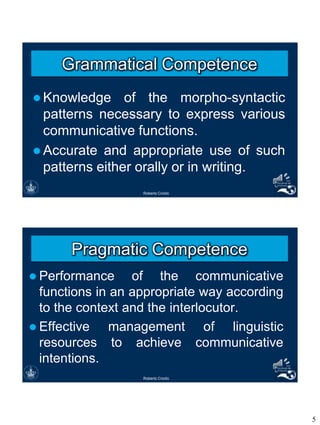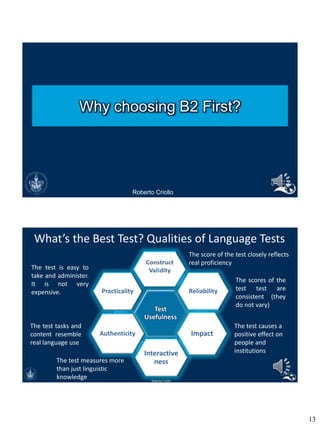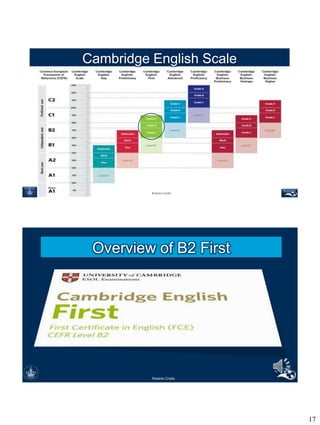ENGLISH-LANGUAGE-PROFICIENCY-TESTS.pdf
- 1. 1 Roberto Criollo Preparing for a successful certification The Common European Framework of Reference for Languages Roberto Criollo
- 2. 2 What is the CEFR? ’ü¼ It is a guide for the design of language programs, textbooks, tests, and other language-related materials. ’ü¼ It describes in a detailed way what learners need to learn in order to use the language for communication and the knowledge and skills they must develop to perform effectively. Roberto Criollo The framework answers 2 main questions ŌĆó What knowledge, skills, and attitudes are necessary to become proficient in a language? ŌĆó What are the different levels of language proficiency? Roberto Criollo
- 3. 3 1) What is Communicative Competence or ŌĆśProficiencyŌĆÖ Roberto Criollo Communicative Competence Savoir faire Savoir Linguistic competence Pragmatic Competence Strategic Competence Phonological Lexical Grammatical Functional Discourse Sociolinguistic Intercultural Communication Learning Savoir ├¬tre Savoir apprendre ŌĆóGenre ŌĆóCohesion ŌĆóCoherence ŌĆóDialect (social, domain) ŌĆóRegister (context, intrl) ŌĆóPlanning ŌĆóCompensating ŌĆóMonitoring and repair ŌĆóPlanning ŌĆóExecuting ŌĆóEvaluating ŌĆóSensitivity ŌĆóOpenness ŌĆóRange ŌĆóAccuracy ŌĆóFluency (suprasegmentals) ŌĆóAccuracy (segmentals) ŌĆóSociopragmatic ŌĆóPragmalinguistic ŌĆóMorphology ŌĆóSyntax CONSTRUCT OF COMMUNICATIVE COMPETENCE (Based on the CEFR) Roberto Criollo
- 4. 4 Phonological Competence Distinction and production of the sounds and the suprasegmental patterns of the language to speak in an accurate and fluent way. Roberto Criollo Lexical Competence ’ü¼ Knowledge of the vocabulary related to different communicative situations. ’ü¼ Appropriate use of this vocabulary in a communicative situation either orally or in writing. Roberto Criollo
- 5. 5 Grammatical Competence ’ü¼ Knowledge of the morpho-syntactic patterns necessary to express various communicative functions. ’ü¼ Accurate and appropriate use of such patterns either orally or in writing. Roberto Criollo Pragmatic Competence ’ü¼ Performance of the communicative functions in an appropriate way according to the context and the interlocutor. ’ü¼ Effective management of linguistic resources to achieve communicative intentions. Roberto Criollo
- 6. 6 Discourse competence ’ü¼ Ability to produce the types of oral or written discourse corresponding to the level: Communicative intentions, rhetorical structure and appropriate register. ’ü¼ Mastery of mechanisms for achieving cohesion and coherence in such discourse types. ’ü¼ Appropriate strategies for comprehending and producing such discourse types. Roberto Criollo Intercultural Competence The ability to understand behavior from the standpoint of the members of a culture and to behave and talk in a way that would be understood by them in the intended way. It involves understanding all aspects of a culture, but particularly the social structure, the values and beliefs of the people, and the way things are assumed to be done and said. Roberto Criollo
- 7. 7 Strategic Competence Management of communication and learning (strategies): Cognitive, meta- cognitive and socio-affective ways for planning, executing, monitoring and evaluating. Roberto Criollo 2) What are the Levels of Proficiency? Roberto Criollo
- 8. 8 CEFR Levels A Basic user A1 Breakthrough A2 Waystage B Independent user B1 Threshold B2 Vantage C Proficient user C1 Efective Operational Proficiency C2 Mastery Common European Framework Roberto Criollo B2 (Vantage): Listening ’ü¼ Understanding extended speech and lectures and follow even complex lines of argument provided the topic is reasonably familiar. ’ü¼ Understanding most TV news, current affair programs, and the majority of films in standard dialect. Roberto Criollo
- 9. 9 B2 (Vantage) Reading ’ü¼ Reading articles and reports concerned with contemporary problems in which the writers adopt particular attitudes or viewpoints. ’ü¼ Understanding contemporary prose. Roberto Criollo B2 (Vantage) Spoken Interaction ’ü¼ Interacting with a degree of fluency and spontaneity that makes regular interaction with native speakers quite possible. ’ü¼ Taking an active part in discussion in familiar topics and contexts, accounting for and sustaining oneŌĆÖs views. Roberto Criollo
- 10. 10 B2 (Vantage) Spoken Production ’ü¼ Presenting clear, detailed descriptions on a wide range of subjects related to oneŌĆÖs field of interest. ’ü¼ Explaining a viewpoint on a topical issue giving the advantages or disadvantages of various options. Roberto Criollo B2 (Vantage) Writing ’ü¼ Writing clear, detailed text on a wide range of subjects related to oneŌĆÖs field of interest. ’ü¼ Writing essays or reports, passing on information or giving reasons in support of or against a particular point of view. ’ü¼ Writing letters highlighting the personal significance of events and experiences. Roberto Criollo
- 11. 11 What is the B2 (Vantage) Level? ’ü¼ B2: Proficiency of a NS after completing high school studies. ’ü¼ The level you would have in Spanish if you took a certification exam. ’ü¼ The level the average native speaker of the language has. C1 and C1 correspond to a highly educated speaker (MA or PhD). Roberto Criollo How difficult is it to attain the B2 level? Roberto Criollo
- 12. 12 Roberto Criollo CENNI Reference Levels Roberto Criollo CENNI Reference Levels 5 lenguas meta 5 lenguas Meta + 8 content courses in English At the end of the program
- 13. 13 Why choosing B2 First? Roberto Criollo WhatŌĆÖs the Best Test? Qualities of Language Tests Test Usefulness Reliability Impact Interactive ness Authenticity Practicality Roberto Criollo The score of the test closely reflects real proficiency The scores of the test test are consistent (they do not vary) The test causes a positive effect on people and institutions The test measures more than just linguistic knowledge The test tasks and content resemble real language use The test is easy to take and administer. It is not very expensive.
- 14. 14 Roberto Criollo ITP Junior If I only want to have my level diagnosed $ 675.00 - $1,369.00 Roberto Criollo
- 15. 15 If I only want to obtain my Diploma ITP $ 940.00 Roberto Criollo If I want to get a Scholarship to the USA or the UK $ 5,000.00 $ 4,287.00 Roberto Criollo
- 16. 16 If I want a permanent international certification First (B2): $4,450 Prof (C2): $4,950 ISE II (B2) $4,132 ISE IV (C2): $5,300 Roberto Criollo Roberto Criollo
- 17. 17 Roberto Criollo Cambridge English Scale Roberto Criollo Overview of B2 First Roberto Criollo
- 18. 18 Roberto Criollo B2 First Structure and Length Roberto Criollo ’ü¼ Total: 3.29 horas ’ü¼ 4 Sections: 1. Reading and Use of English (1h. 15 min.) 2. Writing (1h. 20 min.) 3. Listening (40 min.) 4. Speaking (14 min.)



